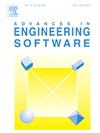IGA_RDTOP:一个紧凑的MATLAB框架,用于使用等几何分析的基于反应扩散的拓扑优化
IF 5.7
2区 工程技术
Q2 COMPUTER SCIENCE, INTERDISCIPLINARY APPLICATIONS
引用次数: 0
摘要
等几何分析在精确的几何表示、高阶连续性、与CAD系统的无缝集成以及在结构拓扑优化中提高复杂几何形状的精度方面具有显著的优势。然而,其实现的复杂性和严格的编码要求对研究人员和学生提出了显着的挑战。为了解决这个问题,我们开发了一个简洁的MATLAB代码,该代码仅由198行组成,将等几何方法集成到基于二维反应扩散的结构优化中。此外,我们引入了一个流线型的3D框架,用于构建基于nurbs的几何图形,执行矩阵操作,管理边界条件,处理初始化和可视化结构。数值实验表明,该算法在30次迭代内具有较强的收敛性,优于现有的公共编码。本研究中的开源实现大大降低了等几何拓扑优化的进入门槛,提供了强大的计算工具和宝贵的教育资源。本文章由计算机程序翻译,如有差异,请以英文原文为准。
IGA_RDTOP: A compact MATLAB framework for reaction-diffusion-based topology optimization using isogeometric analysis
Isogeometric analysis offers significant advantages in precise geometric representation, higher-order continuity, seamless integration with CAD systems, and improved accuracy for complex geometries in structural topology optimization. However, the complexity of its implementation and the rigorous coding requirements present notable challenges for researchers and students. To tackle this issue, we have developed a concise MATLAB code consisting of just 198 lines that incorporates isogeometric methods into 2D reaction-diffusion-based structural optimization. Furthermore, we introduce a streamlined 3D framework for constructing NURBS-based geometries, performing matrix operations, managing boundary conditions, handling initializations, and visualizing structures. Numerical experiments reveal robust convergence within 30 iterations, surpassing the efficiency of existing public codes. The open-source implementations in this study significantly lower the barrier to entry for isogeometric topology optimization, offering a powerful computational tool and a valuable educational resource.
求助全文
通过发布文献求助,成功后即可免费获取论文全文。
去求助
来源期刊

Advances in Engineering Software
工程技术-计算机:跨学科应用
CiteScore
7.70
自引率
4.20%
发文量
169
审稿时长
37 days
期刊介绍:
The objective of this journal is to communicate recent and projected advances in computer-based engineering techniques. The fields covered include mechanical, aerospace, civil and environmental engineering, with an emphasis on research and development leading to practical problem-solving.
The scope of the journal includes:
• Innovative computational strategies and numerical algorithms for large-scale engineering problems
• Analysis and simulation techniques and systems
• Model and mesh generation
• Control of the accuracy, stability and efficiency of computational process
• Exploitation of new computing environments (eg distributed hetergeneous and collaborative computing)
• Advanced visualization techniques, virtual environments and prototyping
• Applications of AI, knowledge-based systems, computational intelligence, including fuzzy logic, neural networks and evolutionary computations
• Application of object-oriented technology to engineering problems
• Intelligent human computer interfaces
• Design automation, multidisciplinary design and optimization
• CAD, CAE and integrated process and product development systems
• Quality and reliability.
 求助内容:
求助内容: 应助结果提醒方式:
应助结果提醒方式:


